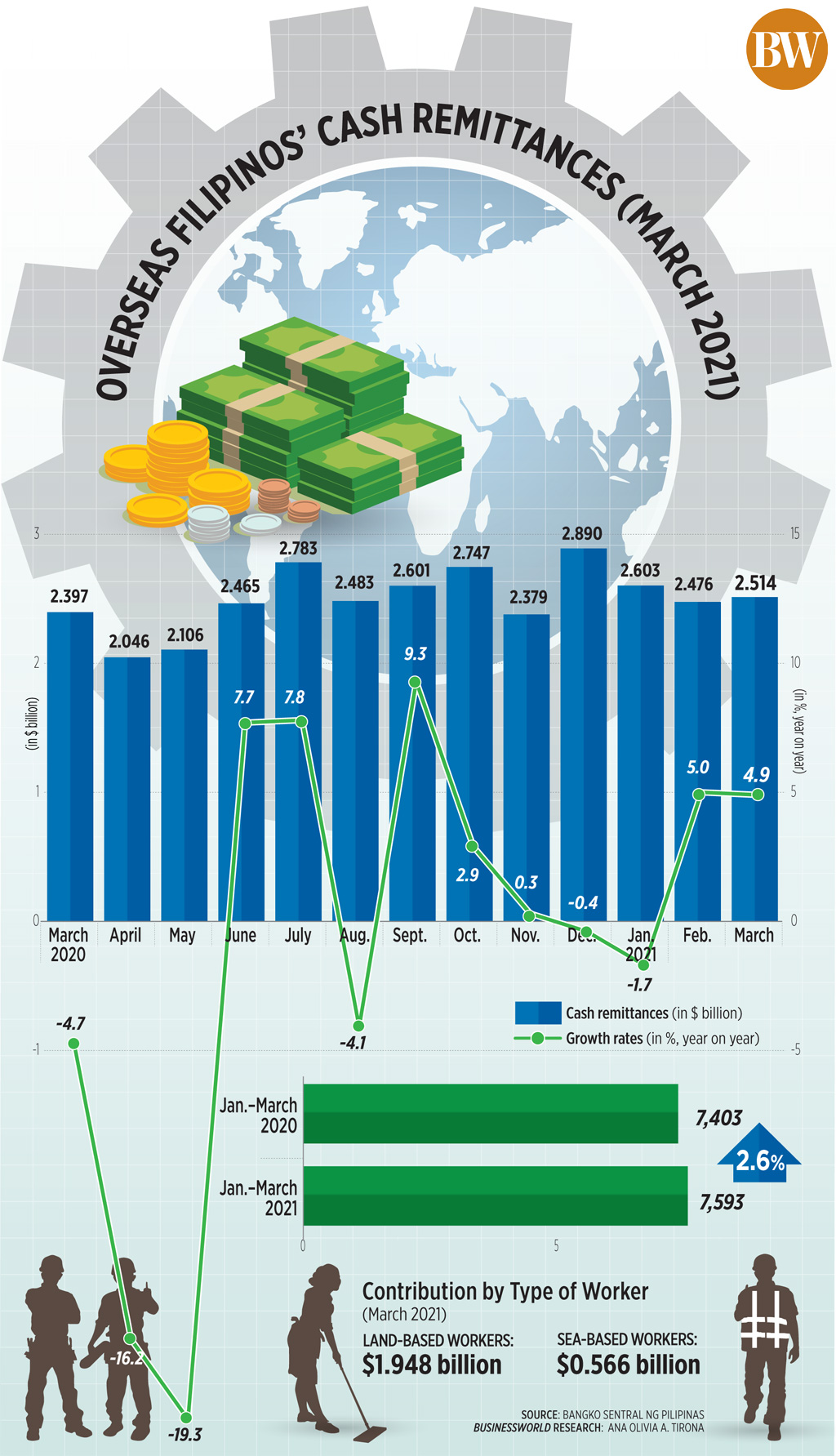By Luz Wendy T. Noble, Reporter
CASH REMITTANCES from overseas Filipino workers (OFWs) rose by 4.9% in March as many host countries start to further ease pandemic-related restrictions as coronavirus disease 2019 (COVID-19) infections drop.
This helped push first-quarter remittances by 2.6% higher at $7.593 billion, data from the central bank showed on Monday.
Cash remittances stood at $2.514 billion in March, higher than the $2.397 billion a year earlier. The month’s remittances went up by 1.53% from the $2.476 billion in February.
“This is the second consecutive month that remittances were higher than last year’s levels, reflecting mainly the easing of travel restrictions, re-opening of borders to foreign workers, and progress in COVID-19 vaccine rollout in many advanced countries,” the Bangko Sentral ng Pilipinas (BSP) said in a statement.
The March growth rate is also a reversal from the 4.7% contraction seen in the same month in 2020, when countries around the world began lockdowns to curb the spike in COVID-19 cases.
According to the BSP, money sent home by land-based OFWs grew by 5% to $1.948 billion in March, while seafarers remitted $566 million, up 4.5% year on year.
Analysts said the Filipino frontline workers abroad helped drive remittances higher, as they sent more money home to help their families.
“OFWs who are medical professionals in host countries have supported the continued growth in OFW remittances since the pandemic,” Rizal Commercial Banking Corp. Chief Economist Michael L. Ricafort said in a Viber message.
Mr. Ricafort said low base effect from the decline last year also supported the growth rate.
Essential workers are not limited to the healthcare sector but also include skilled employees that are much needed in economic recovery, Asian Institute of Management economist John Paolo R. Rivera said.
“People in construction, electricians, housekeeping, and other skilled labor were also in demand abroad to help reboot the economies of their host economies. Some professionals and highly skilled workers have also been deployed when economies started to open slowly,” he said in a Viber message.
In March, the United States remained the country’s top source for remittances, followed by Singapore, Saudi Arabia, Japan, the United Kingdom, the United Arab Emirates, Canada, Qatar, Taiwan, and Malaysia. Together, they accounted for 78.2% of the total cash remittances.
Personal remittances — which include inflows in kind — jumped by 5.6% to $2.801 billion from $2.652 billion in March 2020. In the first three months, personal remittances increased by 2.9% to $8.454 billion.
Remittances are crucial in supporting household spending which makes up 70% of the country’s economy. Last year, remittance inflows dropped by 0.8% to $29.903 billion, the first annual decline since 2001 as some OFWs lost their jobs amid the global health crisis.
Remittances will likely continue to grow in the next few months given migrant workers’ tendency to become altruistic in times of need, Mr. Ricafort said.
“Tighter quarantine restrictions in NCR (National Capital Region) Plus since the latter part of March amid new record high COVID-19 local cases recently could also increase the need to send more remittances to assist adversely affected dependents in the country,” he said.
Tighter quarantine restrictions in Metro Manila and nearby provinces were implemented since late March until early May. The areas are currently under a more relaxed general community quarantine (GCQ) with “heightened restrictions” until the end of May.
For Mr. Rivera, the remittance outlook is still clouded by the COVID-19 situation in the Philippines and overseas.
“If the Philippines will continue to record existence of new variants, this may hamper further deployment of Filipinos coming directly from the Philippines. Also, rising new cases abroad also threatens deployment,” Mr. Rivera said.
He cited Hong Kong, a host country for many domestic helpers, which imposed a two-week travel ban for flights from the Philippines due to the recent surge in COVID-19 cases.
COVID-19 cases in the Philippines surpassed the one million mark in March. The Health department reported 5,979 new infections on Monday, with active cases currently at 54,235.
The country has already recorded COVID-19 cases with the “double mutant” Indian variant as well as other variants deemed to be more infectious by health authorities.
The BSP is hopeful that remittances will recover this year with a growth of 4%.

